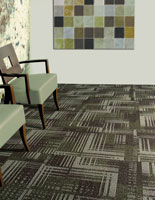 In most economic downturns the commercial sector will lag the residential market by three to six months both going in and coming out. By now, most people know the current economic condition is unlike anything anyone has seen. The result is the commercial sector, at least when it comes to carpet, has not followed the normal pattern and is enjoying a steadying improvement in sales, especially when it comes to modular products.
In most economic downturns the commercial sector will lag the residential market by three to six months both going in and coming out. By now, most people know the current economic condition is unlike anything anyone has seen. The result is the commercial sector, at least when it comes to carpet, has not followed the normal pattern and is enjoying a steadying improvement in sales, especially when it comes to modular products.
From mill executives to contractors, most executives feel that since the fourth quarter of 2010, business has improved in the mid single digits compared to the previous period.
In terms of shipments, sales in the first quarter are estimated to be up 3%, while actual dollars are up 7.7%. The dollar increase is mainly due to price increases resulting from increases in raw materials and energy costs. In fact, most mill executives told FCNews raw materials costs have increase so much in the last two years the price hikes they instituted are still not enough to offset the higher production costs. Last year, they said raw materials rose 8% and they’re already up more than that this year.
In other words, manufacturers say they are still trying to catch up without creating too much of a hardship on the supply chain as they know conditions remain difficult.
Nonetheless, the sector seems relatively content with how things are and how they are progressing.
Ralph Boe, president of Beaulieu of America, said he is “pleased with the recovery we’re seeing in commercial, which we are not seeing in residential. It started toward the end of last year and has continued as many areas got long in the tooth and needed to be updated.”
Tom Lape, president of Mohawk, agreed, noting the commercial area “certainly benefited from the momentum that built throughout 2010. We profited from pipeline work that was related to projects born prior to 2010. They were shelved due to the uncertainty created by the financial crisis in 2008 and 2009. Many were simply awaiting financing as they were renovations of existing facilities and ‘spec ready.’ We expect to see more of these shelved projects entering the pipeline, as the number of projects deferred during the financial crisis certainly exceeds those that came online in 2010.”
As such, he said the company is “cautiously optimistic the industry will continue to drive new project and renovation work both domestically and internationally.”
Shaw’s Tim Baucom, vice president of commercial marketing and sales, added, “Recall, in 2010, sales began to rebound in the second half and were benefited by government stimulus. Sales in 2011 will demonstrate more normal seasonality; therefore the growth rates in the first half of 2011 will be higher due to the relatively weaker comparison period…When the books close on the year, the commercial segment of the carpet industry will have grown 3% to 5%.”
Modular grows
While the commercial carpet segment is looking good overall, everyone is quick to point out the growth continues to come from sales of modular products as opposed to broadloom.
“Tile is the fastest growing segment, even though it is more expensive per square foot,” noted Frank Hurd, COO of the Carpet & Rug Institute. “The commercial sector has realized that carpet tile has a very good life cycle analysis story so in the long run the expense goes down. You can replace just one tile and not the whole floor.”
In its recent report to investors, Interface, the world’s largest maker of carpet tile, explained because a relatively small portion of an installation often receives the bulk of traffic and wear, the ability to rotate carpet tiles between high traffic and low traffic areas and to selectively replace worn tiles “can significantly increase the average life and cost efficiency of the floor covering. In addition, carpet tile facilitates access to subfloor air delivery systems and telephone, electrical, computer and other wiring by lessening disruption of operations. It also eliminates the cumulative damage and unsightly appearance commonly associated with frequent cutting of conventional carpet as utility connections and disconnections are made. [As a result], worldwide demand for modular carpet is increasing as more customers recognize these advantages.”
To emphasis the growth rate of tile, Interface’s first quarter sales were up 13% compared to the first three months of 2010. And, the company feels there is “significant headroom” to keep growing.
Why? Carpet tile currently makes up roughly 31% of the U.S. commercial soft surface market. According to Interface, in Japan tile represents 71% compared to broadloom’s 29%. “The popularity of modular carpet continues to increase compared with other flooring products across most markets, internationally as well as in the United States.”
Within the commercial market, manufacturers differ on how well or poor the various segments are doing, but they all agree the green movement continues to be a driving force in creating sales.
“An increasing percentage of commercial projects require flooring manufacturers to address green issues,” Baucom said. “As more projects seek to be LEED certified, pressure is building for flooring manufacturers to increase recycled content without raising cost, lowering performance or compromising design. The end user wants sustainability without sacrifice.”
Boe said this is “especially important for government projects.”
Lape added, “customers are becoming more adept at sensing a marketing program, as opposed to real and impactful change. When it comes to manufacturer environmental programs, more and more end users are posing hard questions and demanding real answers…Put simply, the trends in sustainable design need to be two things—relevant and real.”
-Matthew Spieler
